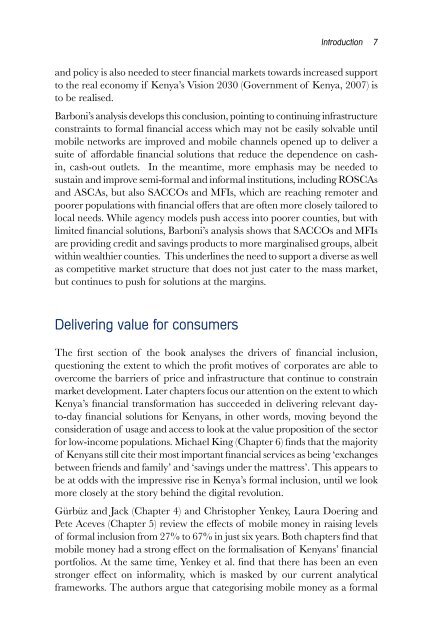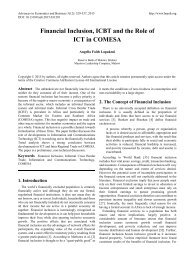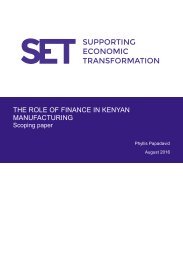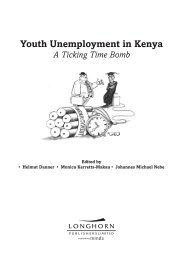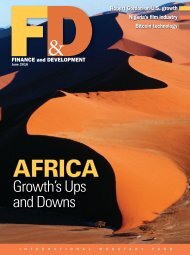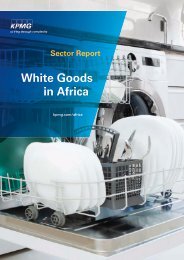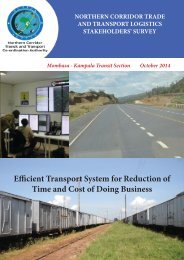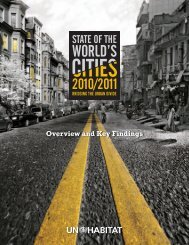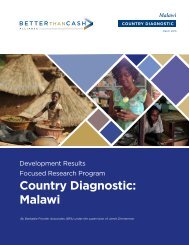in the 21st Century
hTOE305aYVW
hTOE305aYVW
Create successful ePaper yourself
Turn your PDF publications into a flip-book with our unique Google optimized e-Paper software.
Introduction 7<br />
and policy is also needed to steer f<strong>in</strong>ancial markets towards <strong>in</strong>creased support<br />
to <strong>the</strong> real economy if Kenya’s Vision 2030 (Government of Kenya, 2007) is<br />
to be realised.<br />
Barboni’s analysis develops this conclusion, po<strong>in</strong>t<strong>in</strong>g to cont<strong>in</strong>u<strong>in</strong>g <strong>in</strong>frastructure<br />
constra<strong>in</strong>ts to formal f<strong>in</strong>ancial access which may not be easily solvable until<br />
mobile networks are improved and mobile channels opened up to deliver a<br />
suite of affordable f<strong>in</strong>ancial solutions that reduce <strong>the</strong> dependence on cash<strong>in</strong>,<br />
cash-out outlets. In <strong>the</strong> meantime, more emphasis may be needed to<br />
susta<strong>in</strong> and improve semi-formal and <strong>in</strong>formal <strong>in</strong>stitutions, <strong>in</strong>clud<strong>in</strong>g ROSCAs<br />
and ASCAs, but also SACCOs and MFIs, which are reach<strong>in</strong>g remoter and<br />
poorer populations with f<strong>in</strong>ancial offers that are often more closely tailored to<br />
local needs. While agency models push access <strong>in</strong>to poorer counties, but with<br />
limited f<strong>in</strong>ancial solutions, Barboni’s analysis shows that SACCOs and MFIs<br />
are provid<strong>in</strong>g credit and sav<strong>in</strong>gs products to more marg<strong>in</strong>alised groups, albeit<br />
with<strong>in</strong> wealthier counties. This underl<strong>in</strong>es <strong>the</strong> need to support a diverse as well<br />
as competitive market structure that does not just cater to <strong>the</strong> mass market,<br />
but cont<strong>in</strong>ues to push for solutions at <strong>the</strong> marg<strong>in</strong>s.<br />
Deliver<strong>in</strong>g value for consumers<br />
The first section of <strong>the</strong> book analyses <strong>the</strong> drivers of f<strong>in</strong>ancial <strong>in</strong>clusion,<br />
question<strong>in</strong>g <strong>the</strong> extent to which <strong>the</strong> profit motives of corporates are able to<br />
overcome <strong>the</strong> barriers of price and <strong>in</strong>frastructure that cont<strong>in</strong>ue to constra<strong>in</strong><br />
market development. Later chapters focus our attention on <strong>the</strong> extent to which<br />
Kenya’s f<strong>in</strong>ancial transformation has succeeded <strong>in</strong> deliver<strong>in</strong>g relevant dayto-day<br />
f<strong>in</strong>ancial solutions for Kenyans, <strong>in</strong> o<strong>the</strong>r words, mov<strong>in</strong>g beyond <strong>the</strong><br />
consideration of usage and access to look at <strong>the</strong> value proposition of <strong>the</strong> sector<br />
for low-<strong>in</strong>come populations. Michael K<strong>in</strong>g (Chapter 6) f<strong>in</strong>ds that <strong>the</strong> majority<br />
of Kenyans still cite <strong>the</strong>ir most important f<strong>in</strong>ancial services as be<strong>in</strong>g ‘exchanges<br />
between friends and family’ and ‘sav<strong>in</strong>gs under <strong>the</strong> mattress’. This appears to<br />
be at odds with <strong>the</strong> impressive rise <strong>in</strong> Kenya’s formal <strong>in</strong>clusion, until we look<br />
more closely at <strong>the</strong> story beh<strong>in</strong>d <strong>the</strong> digital revolution.<br />
Gürbüz and Jack (Chapter 4) and Christopher Yenkey, Laura Doer<strong>in</strong>g and<br />
Pete Aceves (Chapter 5) review <strong>the</strong> effects of mobile money <strong>in</strong> rais<strong>in</strong>g levels<br />
of formal <strong>in</strong>clusion from 27% to 67% <strong>in</strong> just six years. Both chapters f<strong>in</strong>d that<br />
mobile money had a strong effect on <strong>the</strong> formalisation of Kenyans’ f<strong>in</strong>ancial<br />
portfolios. At <strong>the</strong> same time, Yenkey et al. f<strong>in</strong>d that <strong>the</strong>re has been an even<br />
stronger effect on <strong>in</strong>formality, which is masked by our current analytical<br />
frameworks. The authors argue that categoris<strong>in</strong>g mobile money as a formal


